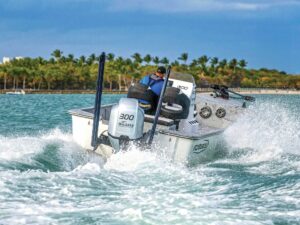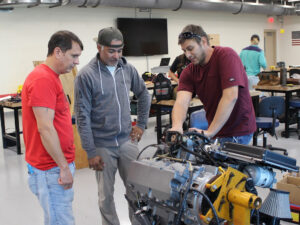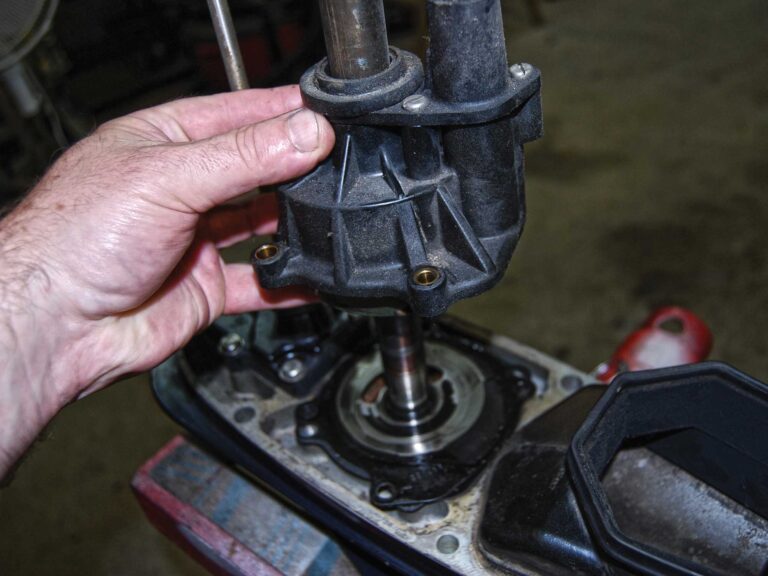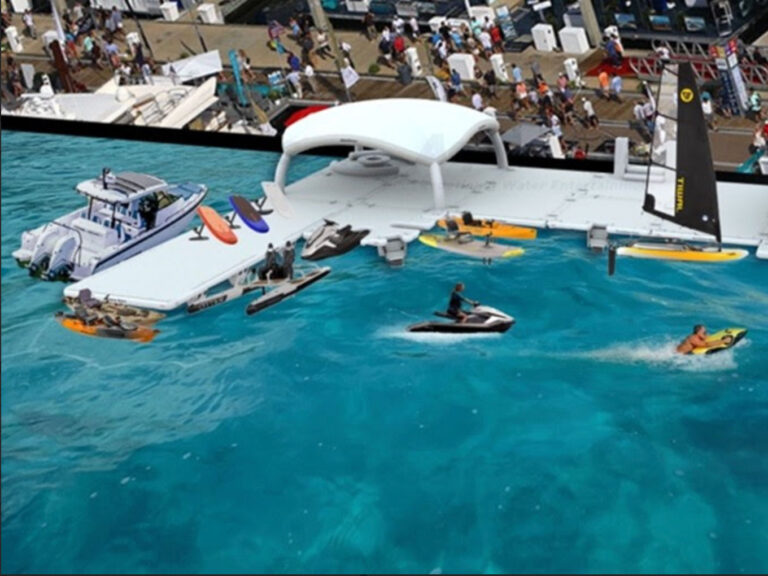
For an all-new model, Sea-Doo‘s GTR-X 230 definitely evokes a distinct feeling of déjà vu. That oh-so-familiar top deck is lifted directly from the RXP-X 300, Sea-Doo’s flagship performance craft. As such, this PWC delivers much of the RXP’s race heritage, though with a more recreationally amenable hull form and a top speed of 66.9 mph.

Settle into the saddle and you’ll note it doesn’t push your thighs wide like the typical broad PWC seat, but narrows through the middle like an hourglass. The shape not only allows riders to keep their legs closer together for comfort, but it also engages their stronger lower-body muscles to keep anchored during aggressive, high-speed turns. Additional leverage is gained from inwardly angled chocks mounted in the footwells, which also serve to keep the knees more naturally aligned. Padded, flared bolsters forward carve out over the thigh to offer additional support.

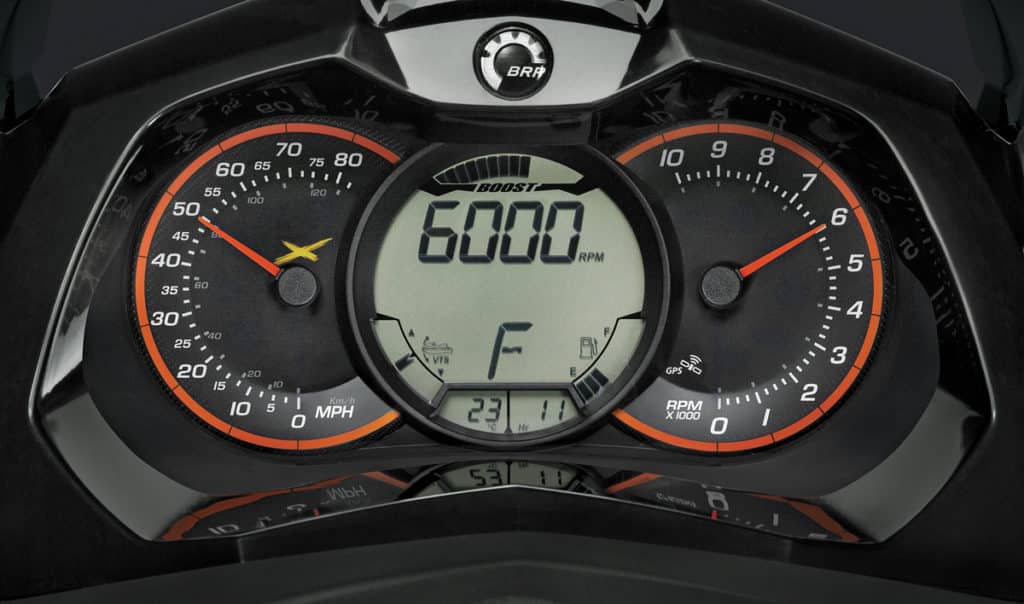
The saddle may steal the spotlight, but don’t overlook the the handlebars. The latter can be adjusted in both the grip angle as well as overall width to further fine-tune the ride to the rider. It’s not a switch accomplished on the fly; Allen bolts must be loosened, meaning the craft will most likely be set up to match the preferred rider and stay that way. But given the performance mindset, that’s probably OK. The choice eliminates much of the play common to PWC steering , resulting in a more solid feel.
Sea-Doo dubs this combination of features Ergolock, alluding to the locked-in feel the rider experiences at the controls. And despite the typical Sea-Doo speak in that title, it’s no marketing gimmick. Fast, agile PWCs really test a rider’s upper-body strength, particularly during aggressive cornering. By transferring much of the strain of these high-performance turns from the weaker upper body to the stronger legs, you’re able to push the limits on an Ergolock-equipped model unlike any comparable model. It’s arguably the closest thing yet to fulfilling the promise of making the rider and craft feel like one.

The style and Ergolock features might make the GTR-X virtually indistinguishable from the RXP-X above the bond line, but below, any comparison abruptly stops. Rather than the latter’s ultra-aggressive shape, the GTR-X hull is borrowed from almost the complete opposite end of the spectrum, namely the brand’s GTI/GTR models. At only 16 degrees, deadrise is a throwback to the sport’s early days, and as such, the GTR-X hull sports a looser, more playful personality. The shape is also relatively straightforward, with none of the dropped keel design that defines the RXP-X. Why the extreme mix and match? Sea-Doo’s stated goal is to offer the performance (not to mention the looks and feel) of a flagship craft at a more affordable price point and an alternative for riders who like the RXP-X style but find its aggressive speed and handling too much.
When comparison shopping, check out Yamaha’s VXR ($11,999). Featuring a 1.8-liter High Output engine, the VXR offers similar speed and performance, despite the absence of a supercharger and a race-inspired saddle to keep the rider secure. The VXR features RiDE, Yamaha’s alternative to Sea-Doo’s Intelligent Brake and Reverse (iBR), but lacks electronic trim.

Sea-Doo powers the GTR-X with a 230 hp, 1,500 cc three-cylinder dubbed the 1500 HO ACE. Mixing the base of the former Rotax 260 with the topside of the 1630 ACE introduced on flagship models in 2016, the engine sports a redesigned four-valve-per-cylinder head, new combustion chamber, improved exhaust and intake porting, and a plasma cylinder coating that sheds weight, reduces friction and improves heat transfer. Performance? We hit 66.9 mph in humid summer conditions, with sub-two-second acceleration from zero to 30 mph.
As for handling, expect the multiple personalities alluded to earlier. Shift your weight and drop the bow via the electronic trim control, and you can carve aggressive corners with a locked-in feel at the stern. Raise that trim a few notches and unweight the stern, and the boat gets loose. You can skid through turns or, with a little practice, even spin out into 180s. We found the learning curve between the boat’s precise and playful personalities relatively short, but don’t let your guard down. Expecting the boat to handle like the RXP-X can cause a few anxious moments.


Standout features include Sea-Doo’s heralded iBR, the system that brought braking power to the personal watercraft market, as well as intuitive forward-neutral-reverse handling. IBR mimics the feeling of gears with its clever positioning of the reverse bucket, and it dramatically shortens stopping distance at speed. It also gives the craft boatlike manners around a crowded dock or launch area for easier handling.
High Points
- Multiple acceleration profiles are easily selectable and tailor power delivery to the ride desired at any time.
- Digitally encoded lanyards act both as keys and speed governors so the captain (owner) can control not only who rides this PWC, but how they ride it.
- High-performance, electronic variable trim allows riders to save two settings that activate with a double-tap of the trim button.
Low Points
- Fill up carefully; fuel fill is located directly adjacent to the bow storage compartment, leaving gear susceptible to spills.
- Though undoubtedly stylish, several parts have a flimsy, plastic feel.
Price: $12,999
Available Power: Jet Drive
How We Tested
- Engine: Supercharged Rotax 1500 HO ACE with external intercooler
- Drive/Prop: 159 mm high-pressure pump with stainless-steel impeller
- Gear Ratio: 1.00:1 Fuel Load: 12 gal. Crew Weight: 155 lb.
More Information

Sea-Doo – Valcourt, Quebec; 888-272–9222; sea-doo.com


